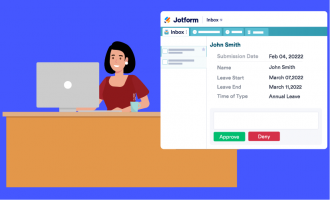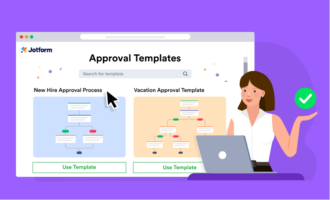As entrepreneurs, we tend to look outside of our companies to reinvigorate our talent pool. In the past year, however, recruiting trends have started to shift. According to a recent LinkedIn survey of over 1,500 talent professionals, internal mobility has increased nearly 20% year over year. Half of those surveyed reported that they expected their recruiting budgets to decrease. Spending on learning and development, on the other hand, is forecasted to stay the same or increase according to two out of three.
At my company, Jotform, we’ve reinstated some of our “Before times” human resources practices, including kicking off our intern program this summer, which is a vital source for new hires. We’ve also renewed our focus on promoting the employees we already have — because it’s well-settled that internal hires cost less and receive higher performance reviews. Research also shows that external hires are slower to adapt and have higher rates of voluntary and involuntary exits. Not to mention, hiring internally boosts employee engagement and loyalty.
The benefits of hiring from within are clear. Here are some of the expert-backed strategies that my team uses in order to promote our top talent.
Strategies for promoting internal hires
1. Recruit for the long-term
Retaining your top employees begins even before their first day on the job — during the hiring process. As Dan Pickett, CEO of Nfrastructure, tells CIO, “It starts with identifying what aspects of culture and strategy you want to emphasize, and then seeking those out in your candidates.”
Take it from Pickett: hiring with those things in mind can improve your employee retention. His company, Nfrastructure, has a retention rate of over 97 percent, extraordinary for any industry.
The employees who stay with your company, who demonstrate their loyalty and dedication to your company’s mission, can be your primary source for recruiting.
2. Invest in learning and development
In times of uncertainty, expenditures on learning and development are often the first to hit the chopping block. But human resources experts insist that nixing learning and development in order to quickly cut costs can jeopardize your company’s long-term growth — and your employee’s advancement.
But before you invest in L&D, start by identifying what kinds of training your employees need. You can do this formally, for example, with development meetings and company-wide surveys, or through informal in-person (or in-Zoom) chats. Afterward, you can assess what kind of continuing education programs will best serve your employees.
Investing in learning and development training is a surefire way to prepare your current employees, who presumably already fit with your company’s culture, to rise among the ranks.
3. Train employees for diverse roles
Another finding from the LinkedIn survey is that traditional roles are increasingly becoming cross-functional, especially during turbulent times. Even recruiting professionals found themselves taking on new duties when hiring slowed during the pandemic.
The clearest path to cross-training employees is regularly soliciting feedback from employees and managers about their interests in learning new roles. One technique that I’ve found facilitates this process is organizing our employees into cross-functional teams. Each team, which functions like an independent micro-company, consists of a senior developer, front end developer, back end developer, designer and CSS developer. Some teams also have project or product managers. Unlike companies where the different departments are siloed, with cross-functional teams, each member deeply understands the others’ roles and responsibilities. It organically generates curiosity and interest in learning diverse roles, where feasible.
So lean into the increasingly cross-functional nature of today’s job descriptions and invest in your employees by preparing them for multiple roles.
4. Utilize technology
Of the various benefits of remote work, one is the proliferation of digital information about employees. That’s why Kon Leong, co-founder and CEO of ZL Technologies, Inc., advocates for moving beyond just intuition and making evidence-based decisions — specifically, utilizing today’s technology to analyze that digital database for important insights about your employees, including which ones merit a promotion.
Look out for key indicators of top performers. As Leong writes for Harvard Business Review, “high-performing employees often leave electronic communication trails that cross departmental boundaries and place them in the center of informal networks — which can be identified through people analytics.” Hiring managers can also use a company’s digital database to identify more general trends, such as which positions have lost significance and new roles to be added.
With people analytics, hiring managers can leverage the troves of information already at the fingertips. But, as Leong cautions, employee privacy should always be paramount.
5. Look beyond performance
When reviewing your current team to determine whether a promotion is in order, performance reviews seem like the obvious place to begin. But I’ve found that other qualities — such as an entrepreneurial spirit, dedication to users, or supportive of co-workers — can be equally important to look for.
For example, let’s say your company is looking to expand into a new market and one of your salespeople puts in the extra mile to secure a customer in that new market. The immediate value may be harder to calculate but the long-term benefit is unquestionable. Or take customer service: while you can’t put a dollar value on great service, studies show that customer experience is becoming the top differentiator for brands.
Think about the qualities you want to reward, beyond performance. Before taking the timely and potentially costly dive into external recruiting, keep an eye out for those qualities in your existing talent pool.
Look within
Sometimes we look outside of our companies to fill a perceived vacancy. But by investing more time and attention in the employees we already have, we not only save our companies vital resources, we infuse our organization with a fresh source of engagement and motivation — and you can’t put a price on that.










































Send Comment: